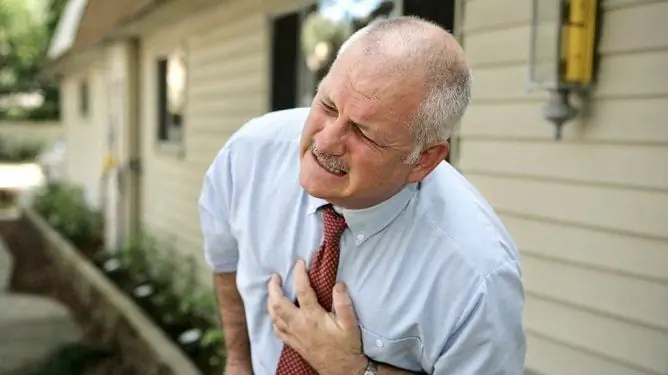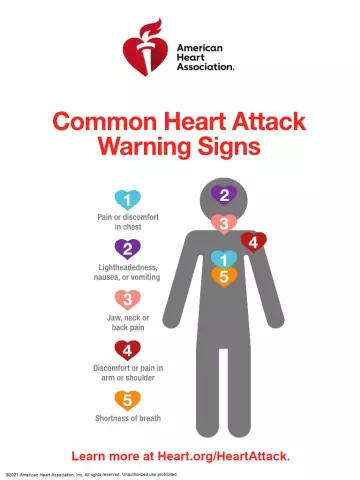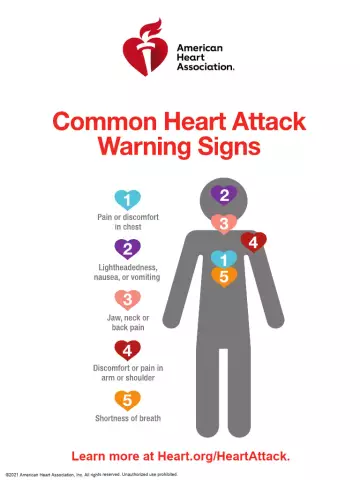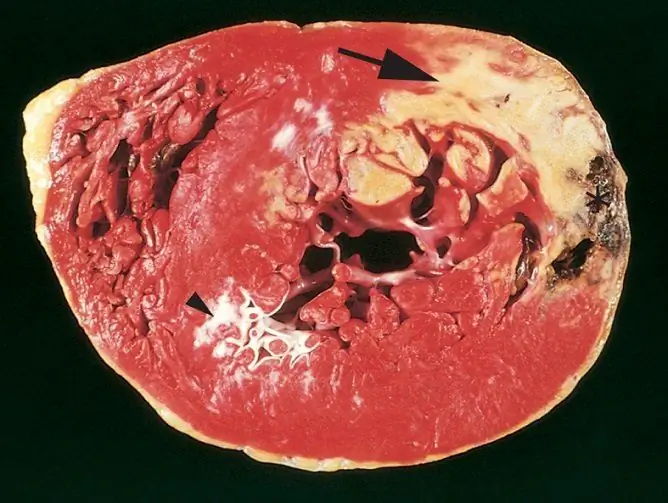- Author Rachel Wainwright [email protected].
- Public 2023-12-15 07:39.
- Last modified 2025-11-02 20:14.
Signs of a heart attack: first symptoms, complications, features of manifestation in men and women
The content of the article:
- How to recognize a heart attack
- How to tell a heart attack from a stroke
- How to identify a heart attack in women and men
- Diagnostics of the heart attack and its complications
- First aid for myocardial infarction
- Video
Signs of a heart attack appear rapidly, so if you do not provide timely first aid, the likelihood of death increases several times. Already within the first few minutes, it is advisable to take measures that reduce the risk of complications in the short and long term. But for this it is necessary to be able to recognize the signs of a heart attack in a patient.

The main symptom of a heart attack is sudden, severe pain in the region of the heart.
How to recognize a heart attack
Myocardial infarction is a necrosis (death of cells and tissues) of the heart muscle caused by acute circulatory disorders. This is an acute process that arises and develops rapidly. The first symptoms of a heart attack appear suddenly, these include:
- acute burning chest pain that radiates to the left shoulder blade, shoulder, arm, jaw, sometimes to the abdomen or perineum. Having arisen, the painful sensations do not subside and are not relieved by conventional anesthetics (in the hospital they are eliminated with narcotic analgesics). The patient holds on to his heart, can instantly weaken, fall;
- interruptions in cardiac activity - arrhythmias and fibrillations. The patient complains of a feeling of irregular heartbeat, uneven heartbeat. A common symptom is a feeling of cardiac arrest accompanied by intense fear;
- pallor of the skin, sticky cold sweat;
- heart failure - usually develops a few hours after the onset of an attack, and sometimes faster, manifests itself as shortness of breath, cyanosis of the skin.
Nonspecific symptoms are also possible, for example, increased blood pressure, weakness, loss of consciousness, shortness of breath. These same signs can be harbingers of future myocardial damage.
It should be borne in mind that patients with diabetes mellitus have a dangerous painless form of the disease. In this case, the patient does not experience pain, but discomfort in the region of the heart.
How to tell a heart attack from a stroke
Sometimes people, describing their problem during an ambulance call, find it difficult to differentiate myocardial infarction from a stroke. Sometimes they are misled by the fact that an ischemic stroke is called a cerebral infarction. It is important to distinguish pathological processes from each other at the initial stage, because treatment and first aid for them are completely different. A stroke is a violation of the blood circulation of the brain, with headache, weakness in the limbs, their paralysis, facial numbness and paralysis of facial muscles, difficulty with speech. With myocardial infarction, the patient complains of sudden pain in the region of the heart and behind the breastbone, palpable disturbances in the work of the heart. He does not complain of pain in the head, numbness and other signs of a stroke.
How to identify a heart attack in women and men
Depending on the gender, the manifestations of a heart attack may differ slightly. The fact is that women and men have different pain thresholds, hormones and natural resistance of the body, therefore the speed and completeness of the reaction to pathology also differ. Differences are also associated with the peculiarities of the work of men and women, as well as with the greater prevalence of bad habits among men.
Statistically, men get sick more often than women. The age of onset of the disease also differs - for men, the critical mark is 40 years. For women, this figure is 50. The highest risk of heart attack among the population is recorded in men over 60 years old.
In men, the first signs of a heart attack appear faster, and in the future, the symptoms appear stronger. As a rule, they have a classic clinical picture of the disease.
A heart attack in women is often more secretive, manifested by stabbing pain in the abdomen, weakness, temporary arrhythmias, but this does not make it less dangerous. Due to late seeking medical care, women have a higher risk of complications.
Diagnostics of the heart attack and its complications
The final diagnosis of myocardial infarction is made not by early symptoms, but by the results of a medical examination. Diagnosis begins in the ambulance - an ECG is performed. According to the data obtained, it is possible to determine the degree of myocardial damage by diagnosing one of four stages, each of which has its own manifestations on the cardiogram. Treatment and prognosis depend on this.
The hospital is conducting two more informative studies - echocardiography and biochemical blood test. EchoCG shows in detail the focus of necrosis, its size, the depth of the lesion of the heart muscle, the location of the supplying vessels, their condition, the condition of the surrounding tissues. A biochemical blood test is necessary to detect special fractions of proteins that are released during the breakdown of myocardial cells - cardiotropic proteins (MV-CPK, LDH1, LDH5, troponin). This is a quick method of confirming the diagnosis - the result can be obtained in an hour. Also, the content of proteins in the active phase of inflammation (C-reactive protein) is used to judge the activity of inflammatory processes.
If the sudden manifestations of the disease are eliminated, the patient is in the hospital under the supervision of doctors, this does not mean that he is already healthy. A heart attack is dangerous for its late complications.
Due to the death of muscle tissue and the appearance of a connective tissue scar on the heart, the affected area will never return to its functions. The main complication of a heart attack is the appearance of heart failure in the patient, and as a result - shortness of breath, pulmonary edema, edema of the extremities, unproductive cough, cardiac conduction disorders.
The inflammatory process can spread to other membranes of the heart. With a large scar, the wall of the heart becomes thinner, after which it can rupture under certain loads.
Thromboembolic complications often occur due to the deterioration of circulation and blood stagnation. A common problem is cardiogenic shock, which can develop in the initial stage of the disease. In the later stages, reperfusion syndrome occurs, associated with the ingress of oxygenated blood to necrotic tissues. The latest, but one of the most dangerous complications is Dressler's syndrome - the body's autoimmune response to its own defective proteins.

It is important that if you suspect a heart attack, the person ends up in the hospital as soon as possible.
First aid for myocardial infarction
When the first signs of a heart attack appear, you should immediately start first aid to the patient. Its survival depends on well-considered actions. The algorithm is as follows:
- Call an ambulance. No matter how qualified assistance is provided to the patient on the spot, he requires immediate hospitalization, a complete diagnosis of heart function, the introduction of a narcotic analgesic to reduce pain and prevent shock. At home, without a doctor and special equipment, all this will not work.
- The patient is seated, calmed. They take off excess clothes, unfasten tight ones so that a person can breathe more freely. All windows are open in the room. The main goal is to increase the amount of oxygen that reaches the starving heart cells.
- If the patient takes drugs for angina pectoris, then it is necessary to give him a nitroglycerin tablet under the tongue. They dilate the coronary vessels - the arteries that feed the heart. It is necessary to find out if a person is allergic to aspirin. In its absence, up to 300 mg of this drug can be given. Any naturally occurring sedative (anti-anxiety) medications can be used to relieve stress.
- Before the arrival of an ambulance, you must be near the patient. If the ambulance cannot arrive quickly for any reason, you can take the person to the hospital by yourself, by car.
If there is a cardiac arrest, it is necessary to urgently start cardiopulmonary resuscitation and carry it out before the arrival of an ambulance or before the resumption of cardiac activity.
Video
We offer for viewing a video on the topic of the article.

Nikita Gaidukov About the author
Education: 4th year student of the Faculty of Medicine No. 1, specializing in General Medicine, Vinnitsa National Medical University. N. I. Pirogov.
Work experience: Nurse of the cardiology department of the Tyachiv Regional Hospital No. 1, geneticist / molecular biologist in the Polymerase Chain Reaction Laboratory at VNMU named after N. I. Pirogov.
Found a mistake in the text? Select it and press Ctrl + Enter.






